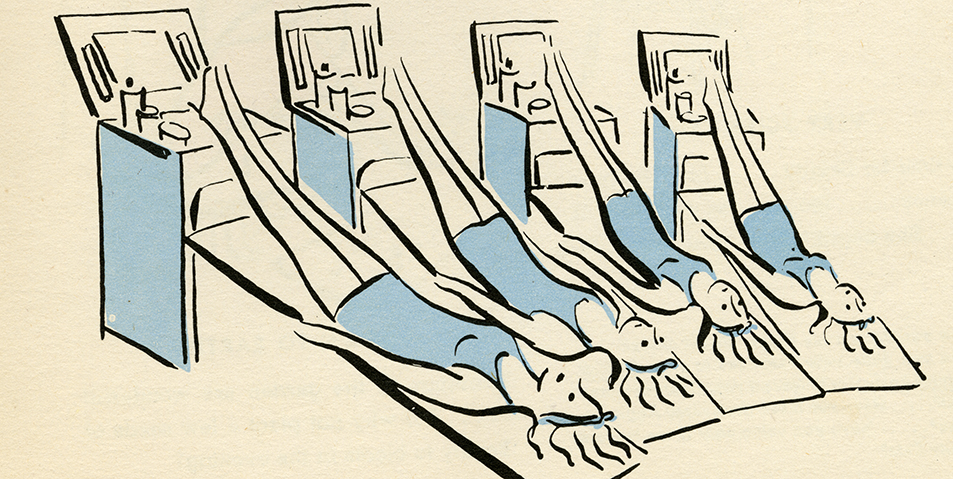
Prevalent during the 1940s, 50s and 60s, charm schools offered day programs in deportment, vocal coaching, makeup and skincare tips, and etiquette training. Not to be confused with finishing schools—which were typically elite boarding schools for wealthy young women—charm schools were a more affordable avenue for learning the social graces and proliferated in heavily populated urban areas, oftentimes operated by modeling agencies and department stores. Bloomingdales, Sears & Roebuck and Montgomery Wards all offered charm schools—often for free—as a client service and also as a means of converting the teen attendees into lifelong loyal customers. A 1959 article in Women’s Wear Daily noted how the Stix department store in St. Louis had more than 1,300 young women aged 10-17 enrolled in their six-week course.
These courses were really a unique form of advertising, a way to promote their brands and sell products, particularly beauty products. But alas, the department stores were NOT the first to come up with this rather ingenious marketing tactic. In 1940, the DuBarry cosmetics company had beat them all to the punch… and with a mail order course no less!
The course was developed in conjunction with leading home economics expert Mary Brooks Picken who headed the Women’s Institute of Domestic Arts and Sciences, a successful correspondence course which is estimated to have had more than 250,000 female subscribers between 1915 and 1933. Through the mail, women enrollees of the Women’s Institute of Domestic Arts and Sciences received training in sewing and the needle arts as well as various other domestic concerns. When Picken was approached by the president of the Du Barry Cosmetics brand about an innovative way to promote their beauty products, Picken developed Du Barry’s own mail order course based on the teachings of the Du Barry Success School, a pricey six week program targeted at preparing soon-to-be debutants for their first social season. Located in New York, Success School enrollees received their training in-person three hours a day, five days a week, for six weeks.
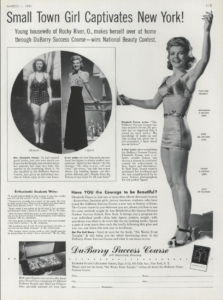 Realizing there was an untapped market of women unable to attend the Success School in-person and at the $5,000 price tag, Picken, her husband, the advertising executive Lynn Sumner, and the School’s director Ann Delafield developed an affordable at-home version incorporating similar diet, exercise, posture and beauty lessons as offered at the School. A mere fraction of the price—approximately $500 in 2019 currency—the Success Course was adverted in the pages of newspapers and magazines across the United States. Over its eight year run, from 1940 to 1948, an estimated 100,000 American women undertook the program (although Du Barry frequently touted its enrollment at closer to 300,000, scholar Catherine Amoroso Leslie has argued otherwise).
Realizing there was an untapped market of women unable to attend the Success School in-person and at the $5,000 price tag, Picken, her husband, the advertising executive Lynn Sumner, and the School’s director Ann Delafield developed an affordable at-home version incorporating similar diet, exercise, posture and beauty lessons as offered at the School. A mere fraction of the price—approximately $500 in 2019 currency—the Success Course was adverted in the pages of newspapers and magazines across the United States. Over its eight year run, from 1940 to 1948, an estimated 100,000 American women undertook the program (although Du Barry frequently touted its enrollment at closer to 300,000, scholar Catherine Amoroso Leslie has argued otherwise).
The Success Course consisted of six weekly folios containing daily lessons. An Elimination Diet was required the first seven days consisting of a daily intake of:
*10-12 oranges *2 apples, pears or peaches *2 tomatoes *2 carrots *1 head of cabbage or lettuce *1 grapefruit *6 stalks of celery *tomato juice *black coffee or tea
Before bedtime women were also advised to also take milk of magnesia to assist in elimination. The equivalent of a modern day ‘cleanse’ the Elimination Diet was touted to flush the intestinal tract and start the enrollee on the path of weight reduction if so desired. Following the Elimination Diet, women were encouraged to “eats as a beauty eats” for the rest of their lives, which was very much in a similar high carb fashion of fruits and vegetables with the addition of a small amount of meat, fish or fowl at the evening meal.

The Course’s exercise program of light calisthenics and stretching is a far cry from the weight lifting, kickboxing and jogging routines of women today, but only in the previous fifty years had cultural attitudes towards women exerting themselves in physical activity begun to change. The Course even cautions women engaged in the recommended exercises to “do these every day… but never to a point of fatigue.” Such an emphasis was placed on proper posture in the program that it proclaimed a 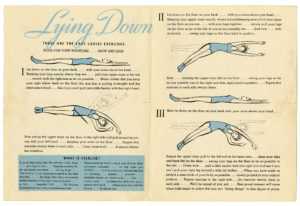 young woman whose spine hangs correctly from behind the ears, “will get pretty much everything she craves out of life… plenty of poise from being accepted at her very attractive face value and the ZIP that gets her jobs and beaux.”
young woman whose spine hangs correctly from behind the ears, “will get pretty much everything she craves out of life… plenty of poise from being accepted at her very attractive face value and the ZIP that gets her jobs and beaux.”
Along with diet and exercise, the beauty routine was not only one of the three main components of the class, it was also a vehicle for selling Du Barry products. Each day a detailed lesson incorporated a variety of the company’s cosmetic products including cleansing and lubricating creams, skin fresheners, exfoliating and hydrating masks as well as a complete line of makeup. Full sets of the products were included in the price of the course with the hopes that, in the words of Lynn Sumner, “if a woman used one group of beauty preparations exclusively for six weeks and during that time received instructions for using them correctly, she would be aware of such beneficial results that she would become a regular customer.”
Our favorite beauty ritual within the Course has to be the Beauty Angle. Lying down with your feet elevated 18 inches above your head, the Beauty Angle “makes gravity work for you because the blood supply to the face and neck is temporarily increased… augmenting the amount of nourishment available to the tissues during this period.” Recommended for at least one hour a day the Beauty Angle was promoted as something you could practice anywhere—at home on your inverted ironing board, on the incline of your cellar door, or outdoors on the slope of a beach or lawn. Given the fact the Course preaches a staunch taboo on applying makeup in public or in view of your family—especially your husband—the promotion of practicing the Beauty Angle out of doors makes a comical juxtaposition in terms of acceptable public behavior today.
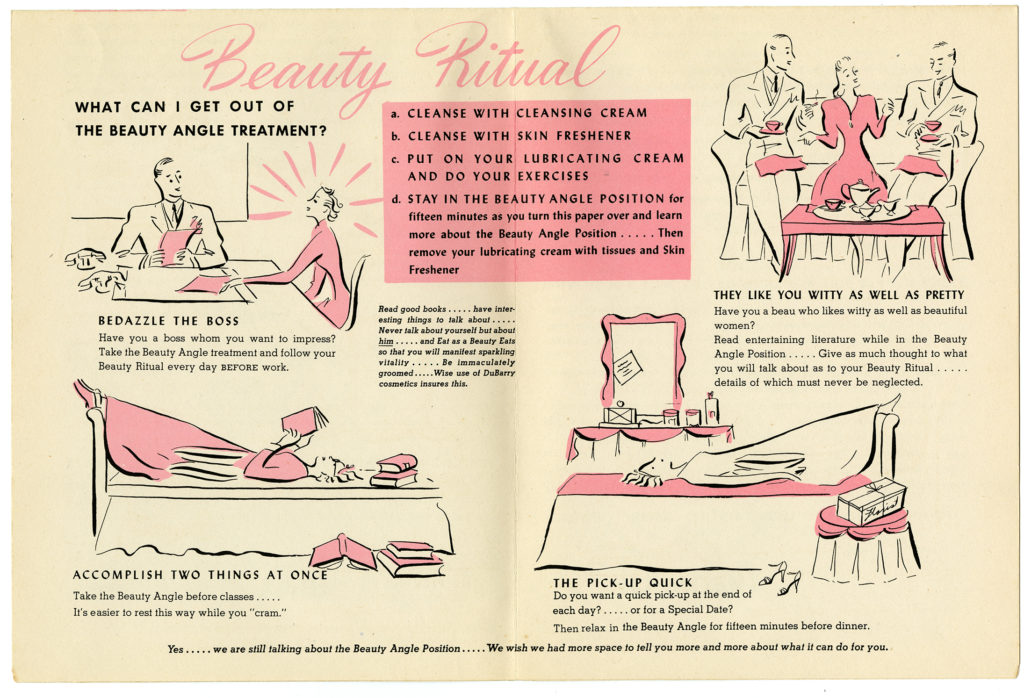
Much of the tone of the Course reads deeply patriarchal to the modern day reader, particularly in the context of dating. Advice like “Talk about him, never look bored, never tell him he’s repeated himself, encourage him to do all the talking, ‘you can get your surplus chat when with your women friends,’ provides a cause to cringe today, but this type of cultural indoctrination was a product of its time and widely regarded as promoting self-improvement. The second wave of feminism was still more than two decades away. In fact, a nation-wide community of women formed around their shared experiences with the Du Barry Success Course. Post Grad newsletters published news of graduates’ success like Elizabeth Grey Stewart who published her first novel and had her first baby the same month. There were letter-writing prizes for women who wrote in with their personal testimonies about how the completing the course changed their life for the better. Many of the letters are incredibly touching such as one from a teenaged girl who had recently immigrated from Iran. She found the Success Course invaluable in helping her assimilate into her high school in upstate New York and was thrilled to have been recently named the Best Dressed Girl in her school.
Seventy-five years later the cultural zeitgeist may have changed, but if the proliferation of transformation-themed television shows stand as a testament, an innate curiosity lives within us all about the unlocked potential within. Who has not sat transfixed to a screen waiting for the ‘big reveal’ of a makeover or a home renovation program? For eight years the Du Barry company parlayed women’s desire for metamorphosis into a big business earning an estimated seven million dollars in tuition fees.
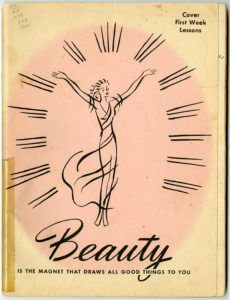
One response to “Charm School Beauty: The Du Barry Success Course”
I am delighted to see this new Material Mode post. I have missed them! As always, interesting and fun. Thank you, April.